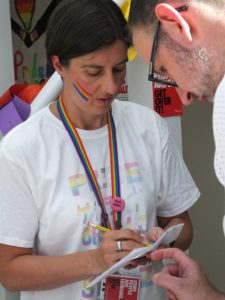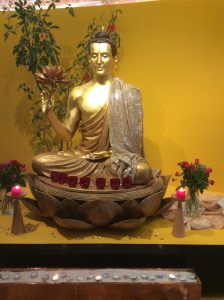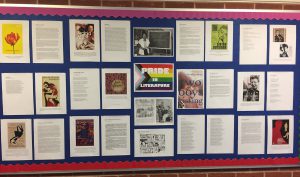Guest blog by Emma Furness, Senior Teacher, English (and Pride aficionado)
When was the last time you made someone’s day? For me, it was earlier this month.
I’ve recently spent time putting up new displays outside my classroom – it’s a highly satisfying job and I always enjoy seeing pupils intrigued by new material or keen to spot their own, or their friends’, work on display.
 Last week, to mark LGBTQ pride month, I collated a display of poems, song lyrics and extracts from novels all by a range of famous LGBTQ authors – some beloved of the literary establishment, some ground-breaking and some radical and controversial. All their work reflects or explores a range of ideas around identity.
Last week, to mark LGBTQ pride month, I collated a display of poems, song lyrics and extracts from novels all by a range of famous LGBTQ authors – some beloved of the literary establishment, some ground-breaking and some radical and controversial. All their work reflects or explores a range of ideas around identity.
It’s not just a flag-waving exercise. All the research tells us young people are most productive when they feel happy and safe. And we know that one way we can foster these feelings in school is to create an environment where all our pupils feel they can be themselves. We encourage them to do just that – be confidently, fully and unapologetically themselves.
A key factor in this is careful consideration of representation. Our pupils speak 23 different languages and are from 30 different national or ethnic backgrounds. They also, obviously, have unique personalities, so between them, they bring a wonderfully rich range of views and experiences to school.
 As a staff, we work to ensure that we celebrate and reflect the fabulous diversity of both our pupils’ lives and the world around them, through lesson content such as poems from a range of cultures in English, the RS department’s visit to the Buddhist Centre in Manchester, the catering staff’s enthusiastic (and delicious) celebration of Chinese New Year, the Maths department’s display of inspiring female mathematicians from around the world, the Diversity Week trip for Year 8 to see ‘A United Kingdom’ and more.
As a staff, we work to ensure that we celebrate and reflect the fabulous diversity of both our pupils’ lives and the world around them, through lesson content such as poems from a range of cultures in English, the RS department’s visit to the Buddhist Centre in Manchester, the catering staff’s enthusiastic (and delicious) celebration of Chinese New Year, the Maths department’s display of inspiring female mathematicians from around the world, the Diversity Week trip for Year 8 to see ‘A United Kingdom’ and more.
The pupils themselves also show us this is important; they relish opportunities to recognise what makes them so brilliantly themselves. A few weeks ago I saw the faces of two younger pupils from Indian families light up when I told them about a Y12 student’s excellent Extended Project about the 1947 Partition of India: the fact that their own history (“My Grandad was there!”) is ‘proper history’, to be studied seriously, clearly delighted them.
 So I chose the writers to feature in my display – a mix of the literary canon and living writers, women and men of different racial backgrounds from Virginia Woolf to David Levithan, and from Shakespeare to Audre Lorde. Then I set to work with my stepladder and staple gun.
So I chose the writers to feature in my display – a mix of the literary canon and living writers, women and men of different racial backgrounds from Virginia Woolf to David Levithan, and from Shakespeare to Audre Lorde. Then I set to work with my stepladder and staple gun.
When I finished, I stepped back to admire my work and started looking for someone to take a celebratory photo for the NGHS Diversity Twitter feed. Two Year 10 pupils, just out of their end-of-year exams, came past and kindly agreed to help. I explained, while posing, what I was doing and why it is important. “That’s so cool,” one of them said. “That’s actually made my day.”
Mine too.